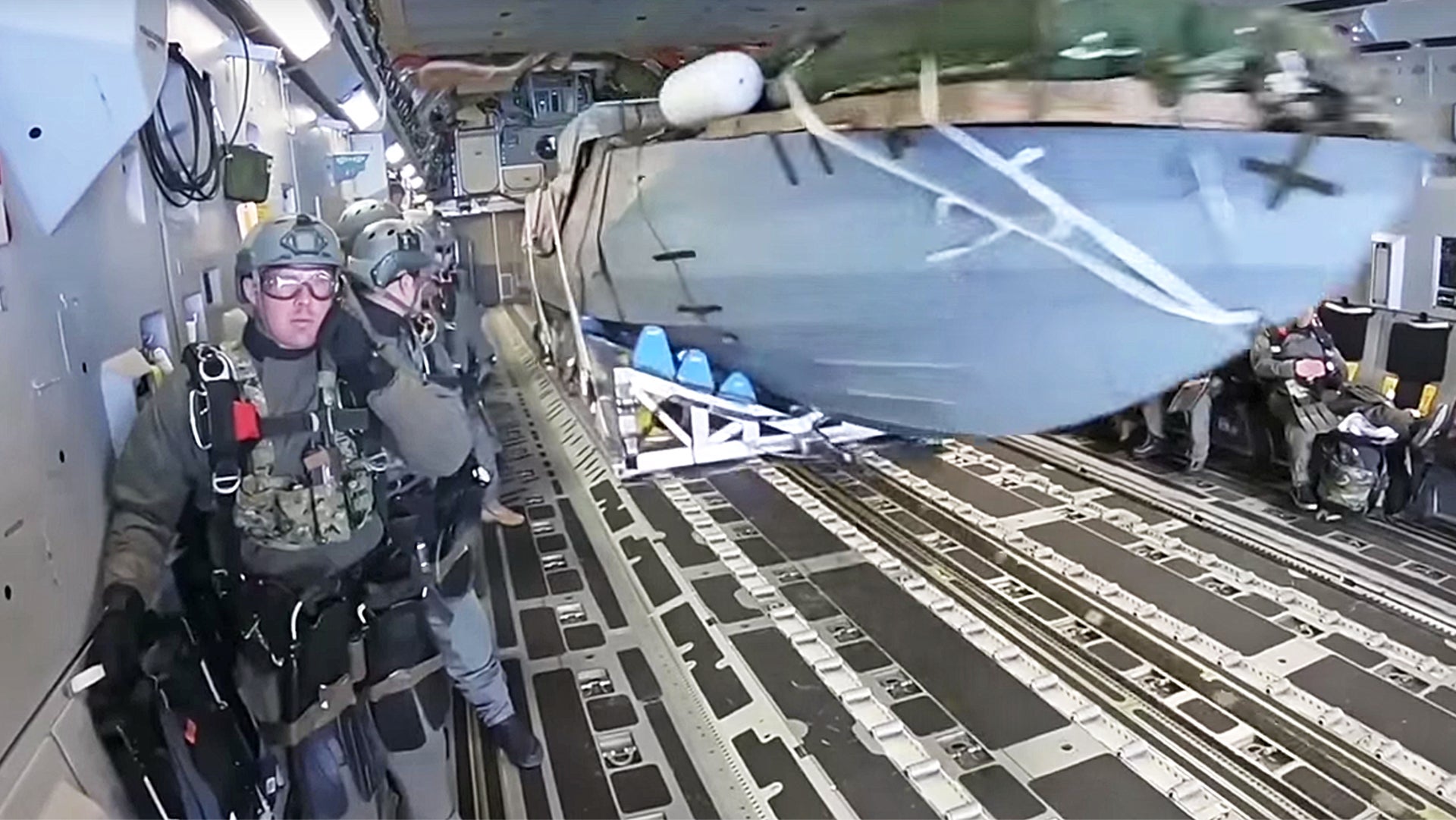We have become somewhat accustomed to seeing special operators jump out of an aircraft and into the ocean along with their rigid-hull inflatable boats (RHIBs), but this week the Navy treated us to a very special video that takes airborne maritime insertion tactics to a whole new level. The video shows Special Warfare Combat-craft Crewmen (SWCCs) of Special Boat Team 20 leaping out of a C-17 behind two of their stealthy Combat Craft Assault (CCA) boats as part of a training evolution. In total, 11 SWCCs followed their rides into the water below.
SWCCs are best known for being a waterborne transit service for Navy SEALs but they also run their own independent operations in the world’s hotspots using a variety of special operations watercraft, some of which are quite exotic. The CCA, in particular, has turned into an increasingly popular platform for SWCCs to deploy with, as it is fast, maneuverable, reconfigurable, and it was designed to have a small radar and infrared signature. But above all else, for a 41-foot monohull open-water craft, it is easily deployable. Two can fit in a single C-17, and if need be, they can be airdropped along with their crews. In this case, the boats were launched via the Low-Velocity Airdrop Delivery System (LVADS).

The War Zone published a special feature on the shadowy Combat Craft Assault boat, as well as some of its stablemates, back in August of 2017. In it we wrote:
From what little we know about the 41-foot long craft, technically known as the CCA Mk. 1, it is low-observable design with a composite material hull and a pair of high-performance engines that could operate with a low likelihood of detection even close to shore. It is reportedly small enough that U.S. Air Force C-17s can airdrop it directly into a given body of water, likely using an arrangement similar to the Maritime Craft Aerial Delivery System (MCADS) for the Naval Special Warfare community’s 36-foot rigid-hull inflatable boats (RHIB), which you can see in the video below.
The Navy specifically purchased the CCAs for medium range missions to insert or extract special operators or to discreetly conduct coastal surveillance, according to one unclassified briefing. Side-folding panels at the rear of the boat may offer additional protection, but there are no obvious provisions for mounted weapons. These fixtures are built inside the boat’s clean outer mold-line or are retractable/removable when not in use to maintain the CCA’s stealthy shape. The crew and passengers would undoubtedly carry individual weapons for self-protection as well.
Each craft has a sensor mast with what may be a small surface search radar, as well as an electro-optical sensor turret with day- and night-vision capabilities. One unclassified 2014 technical report says that at least some of the boats had a satellite communications antenna flush in the top of the bow…
The Navy received the first of these craft from United States Marine, Inc. sometime between 2012 and 2013, though development had started as early as 2010. Production continued until 2014 and the CCA was only expected to reach full operational capability during the 2017 fiscal year.
At present, the craft are split between Special Boat Teams 12 and 20, situated at Naval Amphibious Base Coronado in California and Naval Amphibious Base Little Creek in Virginia respectively. Lockheed Martin has taken over responsibility for maintaining and otherwise supporting CCAs.
Although the previously shy CCAs are becoming more visible to the public, SWCCs became better known following their cameo appearance in the 2012 action movie Act of Valor. That film, which used real military personnel as actors, showed SWCCs executing a hot extraction in a riverine environment, which was probably the most memorable action sequence in the film.


It’s pretty amazing to think that the Navy, with the help of the USAF, can just plunk down the kind of capability the SWCCs and their CCAs provide nearly anywhere on the world’s wet surface where a C-17 can survive above. And clearly SWCCs practice a dangerous art, one in which even the flying fish can get you!:
Contact the author: Tyler@thedrive.com
